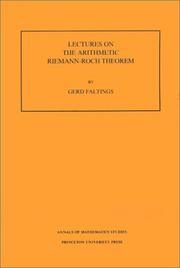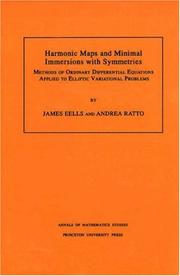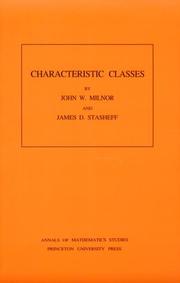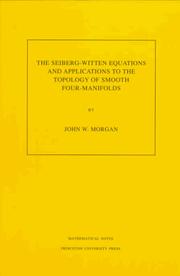| Listing 1 - 7 of 7 |
Sort by
|

ISBN: 0691087717 0691025444 1400882478 Year: 2016 Volume: vol 127 Publisher: Princeton, NJ : Princeton University Press,
Abstract | Keywords | Export | Availability | Bookmark
 Loading...
Loading...Choose an application
- Reference Manager
- EndNote
- RefWorks (Direct export to RefWorks)
The arithmetic Riemann-Roch Theorem has been shown recently by Bismut-Gillet-Soul. The proof mixes algebra, arithmetic, and analysis. The purpose of this book is to give a concise introduction to the necessary techniques, and to present a simplified and extended version of the proof. It should enable mathematicians with a background in arithmetic algebraic geometry to understand some basic techniques in the rapidly evolving field of Arakelov-theory.
Algebraic geometry --- Algebraïsche meetkunde --- Geometry [Algebraic ] --- Géométrie algébrique --- Meetkunde [Algebraïsche ] --- Riemann-Roch theorema's --- Riemann-Roch thoerems --- Theoremes de Riemann-Roch --- Geometry, Algebraic. --- Riemann-Roch theorems. --- Theorems, Riemann-Roch --- Algebraic functions --- Geometry, Algebraic --- Geometry --- Addition. --- Adjoint. --- Alexander Grothendieck. --- Algebraic geometry. --- Analytic torsion. --- Arakelov theory. --- Asymptote. --- Asymptotic expansion. --- Asymptotic formula. --- Big O notation. --- Cartesian coordinate system. --- Characteristic class. --- Chern class. --- Chow group. --- Closed immersion. --- Codimension. --- Coherent sheaf. --- Cohomology. --- Combination. --- Commutator. --- Computation. --- Covariant derivative. --- Curvature. --- Derivative. --- Determinant. --- Diagonal. --- Differentiable manifold. --- Differential form. --- Dimension (vector space). --- Divisor. --- Domain of a function. --- Dual basis. --- E6 (mathematics). --- Eigenvalues and eigenvectors. --- Embedding. --- Endomorphism. --- Exact sequence. --- Exponential function. --- Generic point. --- Heat kernel. --- Injective function. --- Intersection theory. --- K-group. --- Levi-Civita connection. --- Line bundle. --- Linear algebra. --- Local coordinates. --- Mathematical induction. --- Morphism. --- Natural number. --- Neighbourhood (mathematics). --- Parameter. --- Projective space. --- Pullback (category theory). --- Pullback (differential geometry). --- Pullback. --- Riemannian manifold. --- Riemann–Roch theorem. --- Self-adjoint operator. --- Smoothness. --- Sobolev space. --- Stochastic calculus. --- Summation. --- Supertrace. --- Theorem. --- Transition function. --- Upper half-plane. --- Vector bundle. --- Volume form.

ISBN: 0691033218 069110249X 1400882508 9780691033211 9780691102498 Year: 2016 Volume: 130 Publisher: Princeton, NJ : Princeton University Press,
Abstract | Keywords | Export | Availability | Bookmark
 Loading...
Loading...Choose an application
- Reference Manager
- EndNote
- RefWorks (Direct export to RefWorks)
The aim of this book is to study harmonic maps, minimal and parallel mean curvature immersions in the presence of symmetry. In several instances, the latter permits reduction of the original elliptic variational problem to the qualitative study of certain ordinary differential equations: the authors' primary objective is to provide representative examples to illustrate these reduction methods and their associated analysis with geometric and topological applications. The material covered by the book displays a solid interplay involving geometry, analysis and topology: in particular, it includes a basic presentation of 1-cohomogeneous equivariant differential geometry and of the theory of harmonic maps between spheres.
Cartes harmoniques --- Harmonic maps --- Harmonische kaarten --- Immersies (Wiskunde) --- Immersions (Mathematics) --- Immersions (Mathématiques) --- Harmonic maps. --- Differential equations, Elliptic --- Applications harmoniques --- Immersions (Mathematiques) --- Équations différentielles elliptiques --- Numerical solutions. --- Solutions numériques --- Équations différentielles elliptiques --- Solutions numériques --- Differential equations [Elliptic] --- Numerical solutions --- Embeddings (Mathematics) --- Manifolds (Mathematics) --- Mappings (Mathematics) --- Maps, Harmonic --- Arc length. --- Catenary. --- Clifford algebra. --- Codimension. --- Coefficient. --- Compact space. --- Complex projective space. --- Connected sum. --- Constant curvature. --- Corollary. --- Covariant derivative. --- Curvature. --- Cylinder (geometry). --- Degeneracy (mathematics). --- Diagram (category theory). --- Differential equation. --- Differential geometry. --- Elliptic partial differential equation. --- Embedding. --- Energy functional. --- Equation. --- Existence theorem. --- Existential quantification. --- Fiber bundle. --- Gauss map. --- Geometry and topology. --- Geometry. --- Gravitational field. --- Harmonic map. --- Hyperbola. --- Hyperplane. --- Hypersphere. --- Hypersurface. --- Integer. --- Iterative method. --- Levi-Civita connection. --- Lie group. --- Mathematics. --- Maximum principle. --- Mean curvature. --- Normal (geometry). --- Numerical analysis. --- Open set. --- Ordinary differential equation. --- Parabola. --- Quadratic form. --- Sign (mathematics). --- Special case. --- Stiefel manifold. --- Submanifold. --- Suggestion. --- Surface of revolution. --- Symmetry. --- Tangent bundle. --- Theorem. --- Vector bundle. --- Vector space. --- Vertical tangent. --- Winding number. --- Differential equations, Elliptic - Numerical solutions

ISBN: 0691081220 9780691081229 140088182X Year: 1974 Volume: 76 Publisher: Princeton : Princeton University Press,
Abstract | Keywords | Export | Availability | Bookmark
 Loading...
Loading...Choose an application
- Reference Manager
- EndNote
- RefWorks (Direct export to RefWorks)
The theory of characteristic classes provides a meeting ground for the various disciplines of differential topology, differential and algebraic geometry, cohomology, and fiber bundle theory. As such, it is a fundamental and an essential tool in the study of differentiable manifolds.In this volume, the authors provide a thorough introduction to characteristic classes, with detailed studies of Stiefel-Whitney classes, Chern classes, Pontrjagin classes, and the Euler class. Three appendices cover the basics of cohomology theory and the differential forms approach to characteristic classes, and provide an account of Bernoulli numbers.Based on lecture notes of John Milnor, which first appeared at Princeton University in 1957 and have been widely studied by graduate students of topology ever since, this published version has been completely revised and corrected.
Algebraic topology --- Characteristic classes --- Classes caractéristiques --- 515.16 --- #WWIS:d.d. Prof. L. Bouckaert/ALTO --- Classes, Characteristic --- Differential topology --- Topology of manifolds --- Characteristic classes. --- 515.16 Topology of manifolds --- Classes caractéristiques --- Additive group. --- Axiom. --- Basis (linear algebra). --- Boundary (topology). --- Bundle map. --- CW complex. --- Canonical map. --- Cap product. --- Cartesian product. --- Characteristic class. --- Charles Ehresmann. --- Chern class. --- Classifying space. --- Coefficient. --- Cohomology ring. --- Cohomology. --- Compact space. --- Complex dimension. --- Complex manifold. --- Complex vector bundle. --- Complexification. --- Computation. --- Conformal geometry. --- Continuous function. --- Coordinate space. --- Cross product. --- De Rham cohomology. --- Diffeomorphism. --- Differentiable manifold. --- Differential form. --- Differential operator. --- Dimension (vector space). --- Dimension. --- Direct sum. --- Directional derivative. --- Eilenberg–Steenrod axioms. --- Embedding. --- Equivalence class. --- Euler class. --- Euler number. --- Existence theorem. --- Existential quantification. --- Exterior (topology). --- Fiber bundle. --- Fundamental class. --- Fundamental group. --- General linear group. --- Grassmannian. --- Gysin sequence. --- Hausdorff space. --- Homeomorphism. --- Homology (mathematics). --- Homotopy. --- Identity element. --- Integer. --- Interior (topology). --- Isomorphism class. --- J-homomorphism. --- K-theory. --- Leibniz integral rule. --- Levi-Civita connection. --- Limit of a sequence. --- Linear map. --- Metric space. --- Natural number. --- Natural topology. --- Neighbourhood (mathematics). --- Normal bundle. --- Open set. --- Orthogonal complement. --- Orthogonal group. --- Orthonormal basis. --- Partition of unity. --- Permutation. --- Polynomial. --- Power series. --- Principal ideal domain. --- Projection (mathematics). --- Representation ring. --- Riemannian manifold. --- Sequence. --- Singular homology. --- Smoothness. --- Special case. --- Steenrod algebra. --- Stiefel–Whitney class. --- Subgroup. --- Subset. --- Symmetric function. --- Tangent bundle. --- Tensor product. --- Theorem. --- Thom space. --- Topological space. --- Topology. --- Unit disk. --- Unit vector. --- Variable (mathematics). --- Vector bundle. --- Vector space. --- Topologie differentielle --- Classes caracteristiques --- Classes et nombres caracteristiques

ISBN: 1400865166 9781400865161 9780691025971 0691025975 9780691025971 Year: 1996 Publisher: Princeton, New Jersey : Princeton University Press,
Abstract | Keywords | Export | Availability | Bookmark
 Loading...
Loading...Choose an application
- Reference Manager
- EndNote
- RefWorks (Direct export to RefWorks)
The recent introduction of the Seiberg-Witten invariants of smooth four-manifolds has revolutionized the study of those manifolds. The invariants are gauge-theoretic in nature and are close cousins of the much-studied SU(2)-invariants defined over fifteen years ago by Donaldson. On a practical level, the new invariants have proved to be more powerful and have led to a vast generalization of earlier results. This book is an introduction to the Seiberg-Witten invariants. The work begins with a review of the classical material on Spin c structures and their associated Dirac operators. Next comes a discussion of the Seiberg-Witten equations, which is set in the context of nonlinear elliptic operators on an appropriate infinite dimensional space of configurations. It is demonstrated that the space of solutions to these equations, called the Seiberg-Witten moduli space, is finite dimensional, and its dimension is then computed. In contrast to the SU(2)-case, the Seiberg-Witten moduli spaces are shown to be compact. The Seiberg-Witten invariant is then essentially the homology class in the space of configurations represented by the Seiberg-Witten moduli space. The last chapter gives a flavor for the applications of these new invariants by computing the invariants for most Kahler surfaces and then deriving some basic toological consequences for these surfaces.
Four-manifolds (Topology) --- Seiberg-Witten invariants. --- Mathematical physics. --- Physical mathematics --- Physics --- Invariants --- 4-dimensional manifolds (Topology) --- 4-manifolds (Topology) --- Four dimensional manifolds (Topology) --- Manifolds, Four dimensional --- Low-dimensional topology --- Topological manifolds --- Mathematics --- Affine space. --- Affine transformation. --- Algebra bundle. --- Algebraic surface. --- Almost complex manifold. --- Automorphism. --- Banach space. --- Clifford algebra. --- Cohomology. --- Cokernel. --- Complex dimension. --- Complex manifold. --- Complex plane. --- Complex projective space. --- Complex vector bundle. --- Complexification (Lie group). --- Computation. --- Configuration space. --- Conjugate transpose. --- Covariant derivative. --- Curvature form. --- Curvature. --- Differentiable manifold. --- Differential topology. --- Dimension (vector space). --- Dirac equation. --- Dirac operator. --- Division algebra. --- Donaldson theory. --- Duality (mathematics). --- Eigenvalues and eigenvectors. --- Elliptic operator. --- Elliptic surface. --- Equation. --- Fiber bundle. --- Frenet–Serret formulas. --- Gauge fixing. --- Gauge theory. --- Gaussian curvature. --- Geometry. --- Group homomorphism. --- Hilbert space. --- Hodge index theorem. --- Homology (mathematics). --- Homotopy. --- Identity (mathematics). --- Implicit function theorem. --- Intersection form (4-manifold). --- Inverse function theorem. --- Isomorphism class. --- K3 surface. --- Kähler manifold. --- Levi-Civita connection. --- Lie algebra. --- Line bundle. --- Linear map. --- Linear space (geometry). --- Linearization. --- Manifold. --- Mathematical induction. --- Moduli space. --- Multiplication theorem. --- Neighbourhood (mathematics). --- One-form. --- Open set. --- Orientability. --- Orthonormal basis. --- Parameter space. --- Parametric equation. --- Parity (mathematics). --- Partial derivative. --- Principal bundle. --- Projection (linear algebra). --- Pullback (category theory). --- Quadratic form. --- Quaternion algebra. --- Quotient space (topology). --- Riemann surface. --- Riemannian manifold. --- Sard's theorem. --- Sign (mathematics). --- Sobolev space. --- Spin group. --- Spin representation. --- Spin structure. --- Spinor field. --- Subgroup. --- Submanifold. --- Surjective function. --- Symplectic geometry. --- Symplectic manifold. --- Tangent bundle. --- Tangent space. --- Tensor product. --- Theorem. --- Three-dimensional space (mathematics). --- Trace (linear algebra). --- Transversality (mathematics). --- Two-form. --- Zariski tangent space.
Book
Year: 2019 Publisher: MDPI - Multidisciplinary Digital Publishing Institute
Abstract | Keywords | Export | Availability | Bookmark
 Loading...
Loading...Choose an application
- Reference Manager
- EndNote
- RefWorks (Direct export to RefWorks)
Emergent quantum mechanics explores the possibility of an ontology for quantum mechanics. The resurgence of interest in ""deeper-level"" theories for quantum phenomena challenges the standard, textbook interpretation. The book presents expert views that critically evaluate the significance—for 21st century physics—of ontological quantum mechanics, an approach that David Bohm helped pioneer. The possibility of a deterministic quantum theory was first introduced with the original de Broglie-Bohm theory, which has also been developed as Bohmian mechanics. The wide range of perspectives that were contributed to this book on the occasion of David Bohm’s centennial celebration provide ample evidence for the physical consistency of ontological quantum mechanics. The book addresses deeper-level questions such as the following: Is reality intrinsically random or fundamentally interconnected? Is the universe local or nonlocal? Might a radically new conception of reality include a form of quantum causality or quantum ontology? What is the role of the experimenter agent? As the book demonstrates, the advancement of ‘quantum ontology’—as a scientific concept—marks a clear break with classical reality. The search for quantum reality entails unconventional causal structures and non-classical ontology, which can be fully consistent with the known record of quantum observations in the laboratory.
non-locality --- ultraviolet divergence --- constraints --- Kilmister equation --- bohmian mechanics --- epistemic agent --- Bohmian mechanics --- relational space --- Feynman paths --- Langevin equation --- quantum causality --- emergent quantum gravity --- quantum ontology --- interpretations --- emergent quantum state --- undecidable dynamics --- molecule interference --- emergent quantum mechanics --- no-hidden-variables theorems --- mind–body problem --- physical ontology --- quantum foundations --- matter-wave optics --- conscious agent --- diffusion constant --- Bell theorem --- Burgers equation --- objective non-signaling constraint --- self-referential dynamics --- Bell inequality --- interpretation --- photochemistry --- Born rule statistics --- sub-quantum dynamics --- dynamical chaos --- weak measurement --- p-adic metric --- Levi-Civita connection --- David Bohm --- H-theorem --- the causal arrow of time --- strong coupling --- vortical dynamics --- fundamental irreversibility --- magnetic deflectometry --- quantum thermodynamics --- de Broglie–Bohm interpretation of quantum mechanics --- wavefunction nodes --- stochastic quantum dynamics --- entropic gravity --- metrology --- Schrödinger equation --- gauge freedom --- Monte Carlo simulations --- micro-constituents --- nonequilibrium thermodynamics --- Bell’s theorem --- emergent space-time --- spin --- quantum field theory --- time-symmetry --- Gaussian-like solutions --- Hamiltonian --- number theory --- fractional velocity --- ergodicity --- fractal geometry --- atomic metastable states --- operator thermodynamic functions --- Canonical Presentation --- Retrocausation --- interpretations of quantum mechanics --- Bohm theory --- quantum mechanics --- zero-point field --- conspiracy --- pilot wave --- quantum holism --- toy-models --- curvature tensor --- Aharonov–Bohm effect --- computational irreducibility --- Stochastic Electrodynamics --- diffraction --- retrocausality --- resonances in quantum systems --- stochastic differential equations --- Bianchi identity --- past of the photon --- commutator --- relational interpretation of quantum mechanics --- free will --- nomology --- trajectories --- primitive ontology --- Mach–Zehnder interferometer --- weak values --- singular limit --- interior-boundary condition --- Poincaré recurrence --- quantum inaccessibility --- symplectic camel --- surrealistic trajectories --- observables --- Stern-Gerlach --- decoherence --- quantum non-equilibrium --- generalized Lagrangian paths --- superdeterminism --- black hole thermodynamics --- nonlocality --- measurement problem --- entropy and time evolution --- bouncing oil droplets --- spontaneous state reduction --- quantum theory --- many interacting worlds --- complex entropy. --- Turing incomputability --- iterant --- space-time fluctuations --- quantum potential --- ontological quantum mechanics --- photon trajectory --- Dove prism --- the Friedrichs model --- contextuality --- discrete calculus --- transition probability amplitude --- gravity --- pilot-wave theory --- matter-waves --- de Broglie-Bohm theory --- covariant quantum gravity --- atom-surface scattering --- de Broglie–Bohm theory
Book
Year: 2019 Publisher: MDPI - Multidisciplinary Digital Publishing Institute
Abstract | Keywords | Export | Availability | Bookmark
 Loading...
Loading...Choose an application
- Reference Manager
- EndNote
- RefWorks (Direct export to RefWorks)
Emergent quantum mechanics explores the possibility of an ontology for quantum mechanics. The resurgence of interest in ""deeper-level"" theories for quantum phenomena challenges the standard, textbook interpretation. The book presents expert views that critically evaluate the significance—for 21st century physics—of ontological quantum mechanics, an approach that David Bohm helped pioneer. The possibility of a deterministic quantum theory was first introduced with the original de Broglie-Bohm theory, which has also been developed as Bohmian mechanics. The wide range of perspectives that were contributed to this book on the occasion of David Bohm’s centennial celebration provide ample evidence for the physical consistency of ontological quantum mechanics. The book addresses deeper-level questions such as the following: Is reality intrinsically random or fundamentally interconnected? Is the universe local or nonlocal? Might a radically new conception of reality include a form of quantum causality or quantum ontology? What is the role of the experimenter agent? As the book demonstrates, the advancement of ‘quantum ontology’—as a scientific concept—marks a clear break with classical reality. The search for quantum reality entails unconventional causal structures and non-classical ontology, which can be fully consistent with the known record of quantum observations in the laboratory.
non-locality --- ultraviolet divergence --- constraints --- Kilmister equation --- bohmian mechanics --- epistemic agent --- Bohmian mechanics --- relational space --- Feynman paths --- Langevin equation --- quantum causality --- emergent quantum gravity --- quantum ontology --- interpretations --- emergent quantum state --- undecidable dynamics --- molecule interference --- emergent quantum mechanics --- no-hidden-variables theorems --- mind–body problem --- physical ontology --- quantum foundations --- matter-wave optics --- conscious agent --- diffusion constant --- Bell theorem --- Burgers equation --- objective non-signaling constraint --- self-referential dynamics --- Bell inequality --- interpretation --- photochemistry --- Born rule statistics --- sub-quantum dynamics --- dynamical chaos --- weak measurement --- p-adic metric --- Levi-Civita connection --- David Bohm --- H-theorem --- the causal arrow of time --- strong coupling --- vortical dynamics --- fundamental irreversibility --- magnetic deflectometry --- quantum thermodynamics --- de Broglie–Bohm interpretation of quantum mechanics --- wavefunction nodes --- stochastic quantum dynamics --- entropic gravity --- metrology --- Schrödinger equation --- gauge freedom --- Monte Carlo simulations --- micro-constituents --- nonequilibrium thermodynamics --- Bell’s theorem --- emergent space-time --- spin --- quantum field theory --- time-symmetry --- Gaussian-like solutions --- Hamiltonian --- number theory --- fractional velocity --- ergodicity --- fractal geometry --- atomic metastable states --- operator thermodynamic functions --- Canonical Presentation --- Retrocausation --- interpretations of quantum mechanics --- Bohm theory --- quantum mechanics --- zero-point field --- conspiracy --- pilot wave --- quantum holism --- toy-models --- curvature tensor --- Aharonov–Bohm effect --- computational irreducibility --- Stochastic Electrodynamics --- diffraction --- retrocausality --- resonances in quantum systems --- stochastic differential equations --- Bianchi identity --- past of the photon --- commutator --- relational interpretation of quantum mechanics --- free will --- nomology --- trajectories --- primitive ontology --- Mach–Zehnder interferometer --- weak values --- singular limit --- interior-boundary condition --- Poincaré recurrence --- quantum inaccessibility --- symplectic camel --- surrealistic trajectories --- observables --- Stern-Gerlach --- decoherence --- quantum non-equilibrium --- generalized Lagrangian paths --- superdeterminism --- black hole thermodynamics --- nonlocality --- measurement problem --- entropy and time evolution --- bouncing oil droplets --- spontaneous state reduction --- quantum theory --- many interacting worlds --- complex entropy. --- Turing incomputability --- iterant --- space-time fluctuations --- quantum potential --- ontological quantum mechanics --- photon trajectory --- Dove prism --- the Friedrichs model --- contextuality --- discrete calculus --- transition probability amplitude --- gravity --- pilot-wave theory --- matter-waves --- de Broglie-Bohm theory --- covariant quantum gravity --- atom-surface scattering --- de Broglie–Bohm theory
Book
Year: 2019 Publisher: MDPI - Multidisciplinary Digital Publishing Institute
Abstract | Keywords | Export | Availability | Bookmark
 Loading...
Loading...Choose an application
- Reference Manager
- EndNote
- RefWorks (Direct export to RefWorks)
Emergent quantum mechanics explores the possibility of an ontology for quantum mechanics. The resurgence of interest in ""deeper-level"" theories for quantum phenomena challenges the standard, textbook interpretation. The book presents expert views that critically evaluate the significance—for 21st century physics—of ontological quantum mechanics, an approach that David Bohm helped pioneer. The possibility of a deterministic quantum theory was first introduced with the original de Broglie-Bohm theory, which has also been developed as Bohmian mechanics. The wide range of perspectives that were contributed to this book on the occasion of David Bohm’s centennial celebration provide ample evidence for the physical consistency of ontological quantum mechanics. The book addresses deeper-level questions such as the following: Is reality intrinsically random or fundamentally interconnected? Is the universe local or nonlocal? Might a radically new conception of reality include a form of quantum causality or quantum ontology? What is the role of the experimenter agent? As the book demonstrates, the advancement of ‘quantum ontology’—as a scientific concept—marks a clear break with classical reality. The search for quantum reality entails unconventional causal structures and non-classical ontology, which can be fully consistent with the known record of quantum observations in the laboratory.
non-locality --- ultraviolet divergence --- constraints --- Kilmister equation --- bohmian mechanics --- epistemic agent --- Bohmian mechanics --- relational space --- Feynman paths --- Langevin equation --- quantum causality --- emergent quantum gravity --- quantum ontology --- interpretations --- emergent quantum state --- undecidable dynamics --- molecule interference --- emergent quantum mechanics --- no-hidden-variables theorems --- mind–body problem --- physical ontology --- quantum foundations --- matter-wave optics --- conscious agent --- diffusion constant --- Bell theorem --- Burgers equation --- objective non-signaling constraint --- self-referential dynamics --- Bell inequality --- interpretation --- photochemistry --- Born rule statistics --- sub-quantum dynamics --- dynamical chaos --- weak measurement --- p-adic metric --- Levi-Civita connection --- David Bohm --- H-theorem --- the causal arrow of time --- strong coupling --- vortical dynamics --- fundamental irreversibility --- magnetic deflectometry --- quantum thermodynamics --- de Broglie–Bohm interpretation of quantum mechanics --- wavefunction nodes --- stochastic quantum dynamics --- entropic gravity --- metrology --- Schrödinger equation --- gauge freedom --- Monte Carlo simulations --- micro-constituents --- nonequilibrium thermodynamics --- Bell’s theorem --- emergent space-time --- spin --- quantum field theory --- time-symmetry --- Gaussian-like solutions --- Hamiltonian --- number theory --- fractional velocity --- ergodicity --- fractal geometry --- atomic metastable states --- operator thermodynamic functions --- Canonical Presentation --- Retrocausation --- interpretations of quantum mechanics --- Bohm theory --- quantum mechanics --- zero-point field --- conspiracy --- pilot wave --- quantum holism --- toy-models --- curvature tensor --- Aharonov–Bohm effect --- computational irreducibility --- Stochastic Electrodynamics --- diffraction --- retrocausality --- resonances in quantum systems --- stochastic differential equations --- Bianchi identity --- past of the photon --- commutator --- relational interpretation of quantum mechanics --- free will --- nomology --- trajectories --- primitive ontology --- Mach–Zehnder interferometer --- weak values --- singular limit --- interior-boundary condition --- Poincaré recurrence --- quantum inaccessibility --- symplectic camel --- surrealistic trajectories --- observables --- Stern-Gerlach --- decoherence --- quantum non-equilibrium --- generalized Lagrangian paths --- superdeterminism --- black hole thermodynamics --- nonlocality --- measurement problem --- entropy and time evolution --- bouncing oil droplets --- spontaneous state reduction --- quantum theory --- many interacting worlds --- complex entropy. --- Turing incomputability --- iterant --- space-time fluctuations --- quantum potential --- ontological quantum mechanics --- photon trajectory --- Dove prism --- the Friedrichs model --- contextuality --- discrete calculus --- transition probability amplitude --- gravity --- pilot-wave theory --- matter-waves --- de Broglie-Bohm theory --- covariant quantum gravity --- atom-surface scattering --- de Broglie–Bohm theory
| Listing 1 - 7 of 7 |
Sort by
|

 Search
Search Feedback
Feedback About
About Help
Help News
News